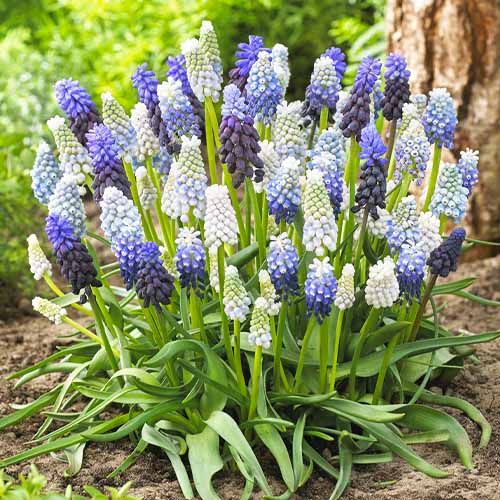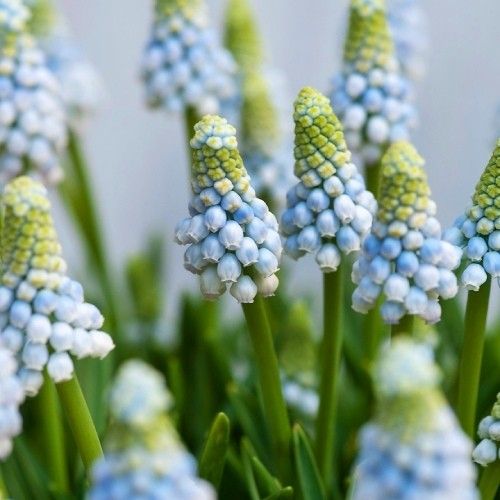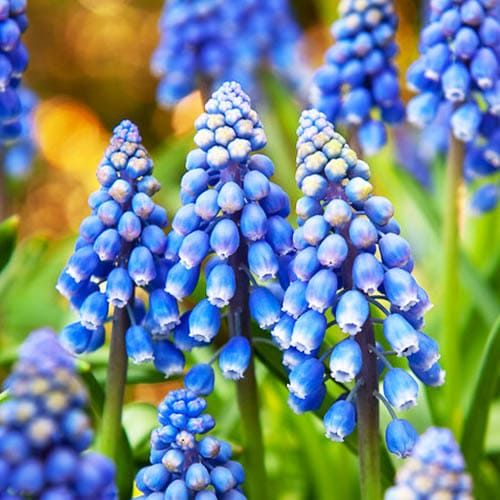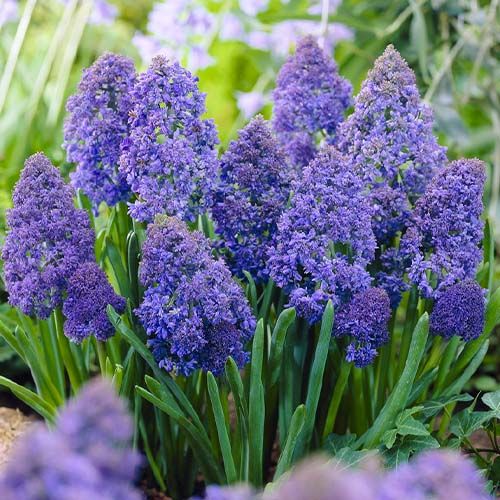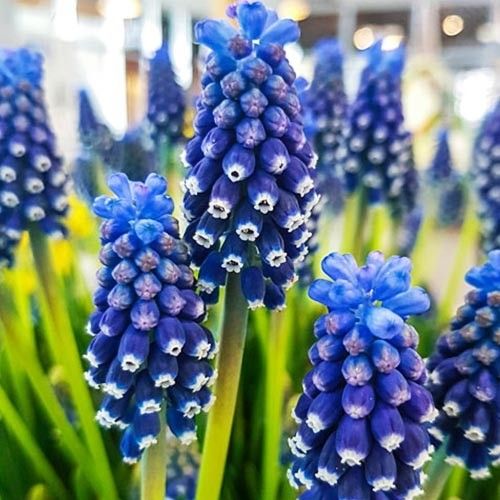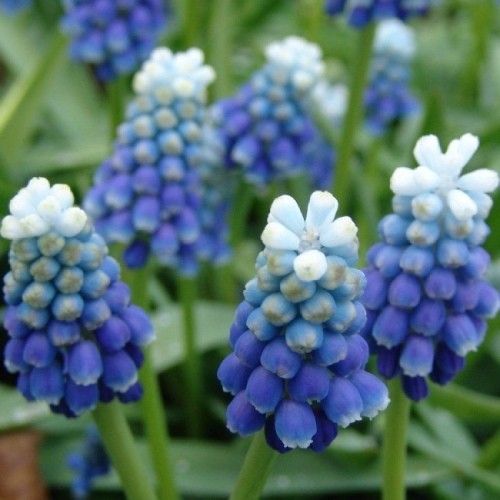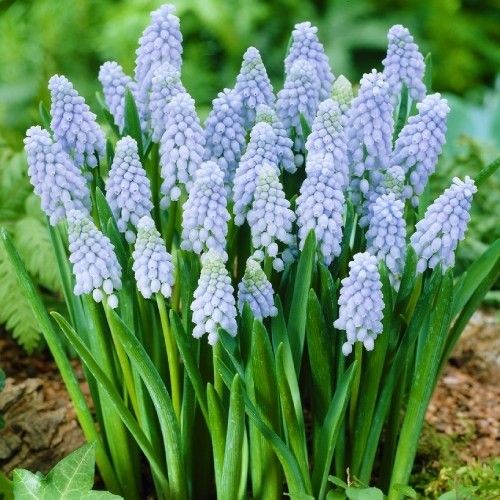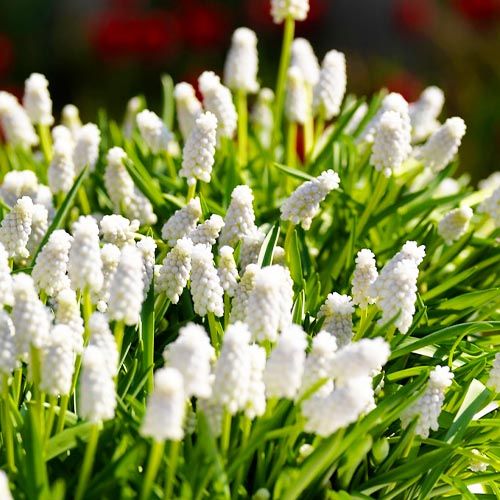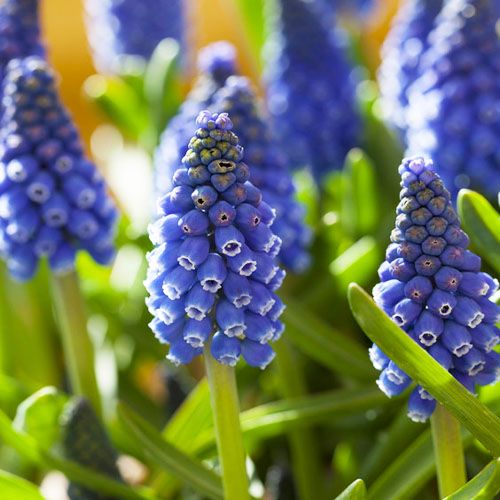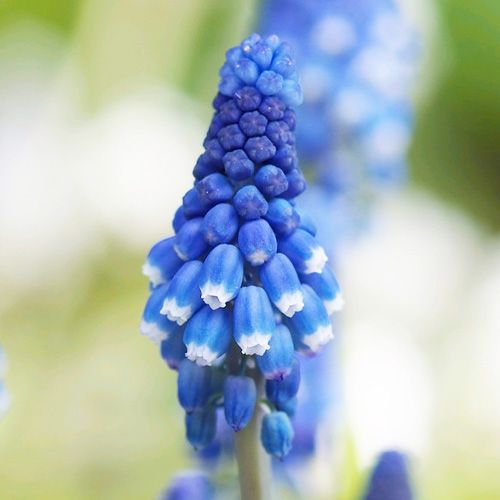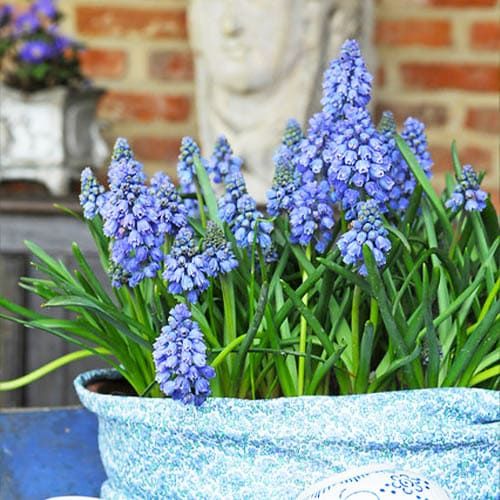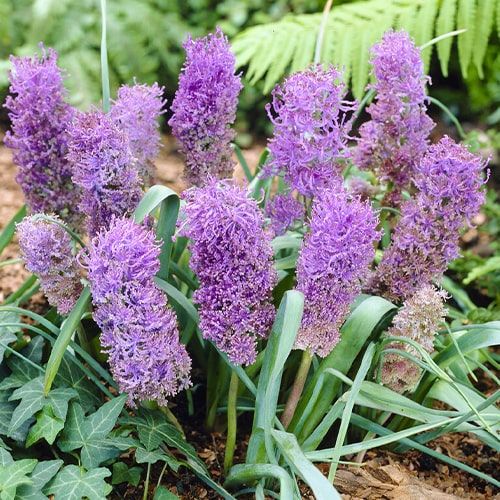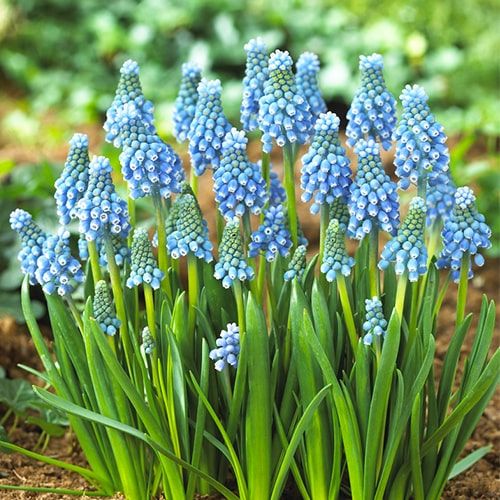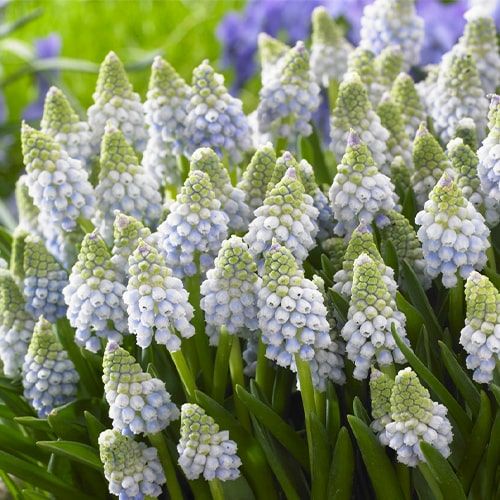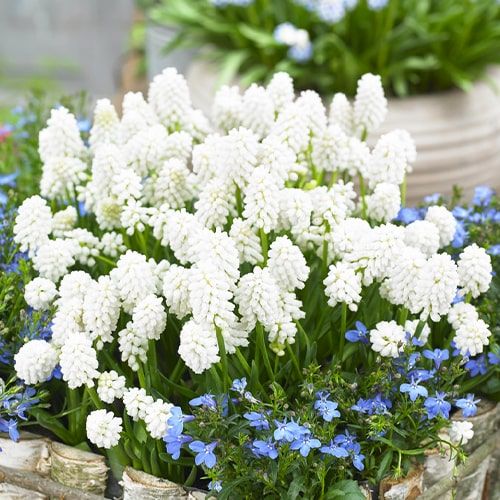
Muscaris
MUSCARI
Last Reviews
Muscari: Delicate Blooms to Enhance Your Garden
Are you in search of a splendid and effortlessly cultivated plant to enhance your garden or indoor space? Allow me to introduce you to Muscari. These delightful flowers have gained popularity among both gardening enthusiasts and flower lovers due to their enchanting beauty and easy-to-manage qualities. In this article, we will delve into the various types of Muscari bulbs, their distinctive features, guidelines for planting and tending to them, as well as design inspirations to ignite your creativity.
The Enchanting Beauty of Muscari Flowers
Muscari, commonly referred to as Grape Hyacinths, belong to the perennial bulbous plant genus native to Eurasia. These charming flowers are renowned for their bell-shaped blossoms, reminiscent of clusters of grapes. The color palette of Muscari varies from rich blues to delicate pinks, whites, and even vibrant yellows. Along with their visual appeal, Muscari flowers emit a sweet fragrance that acts as a magnet for pollinators such as bees and butterflies. Whether cultivated indoors or outdoors, Muscari thrives splendidly, making them a versatile choice for any environment or setting.
Varieties of Muscari Bulbs
The Muscari genus encompasses over 40 distinct species, each possessing its own unique characteristics and specific growth requirements. Here are some notable and popular varieties:
- Muscari armeniacum: This particular species is widely cherished, featuring vibrant blue flowers accompanied by a delightful fragrance. Its blossoms typically emerge in late spring, while the plant reaches a height of approximately 6 inches.
- Muscari latifolium: A captivating variety that showcases two-toned flowers, with a deep blue hue at the base and a pale pink shade on top. It blooms during the early to mid-spring period and can reach a height of about 8 inches.
- Muscari aucheri: This species boasts white flowers adorned with a light blue stripe running through the center of each petal. Its blooming season occurs in late spring, while the plant can grow to around 10 inches tall.
These are just a few examples of the diverse and captivating Muscari varieties available, each offering its own distinctive beauty to enhance your garden or indoor space.
Characteristics of Muscari Blooms
Muscari flowers are renowned for their delicate and enchanting allure. These blooms are generally petite, measuring about 1/2 inch in diameter, yet they cluster together, forming mesmerizing arrangements that can encompass up to 50 individual flowers. The leaves of Muscari are slender and resemble grass, growing to a length of approximately 6-8 inches. One of the notable attributes of Muscari bulbs is their resilience, as they are capable of withstanding diverse temperature ranges and adapting to various soil conditions. This quality makes Muscari an excellent choice for novice gardeners seeking a hardy and versatile plant to cultivate.
Planting and Growing Muscari Bulbs
If you`re interested in planting Muscari bulbs, here are some tips to get you started:
Choosing the Right Location
Muscari bulbs thrive best in a location that offers a balance of sunlight and partial shade, while also ensuring proper drainage. Although they can tolerate different soil types, Muscari bulbs have a preference for slightly acidic soil. When selecting a spot for planting, it is important to consider protection from strong winds, as these can potentially harm the delicate blooms. By providing these optimal conditions, you can encourage healthy growth and enjoy the beauty of Muscari flowers to their fullest extent.
Preparing the Soil for Muscari Bulbs
Prior to planting Muscari bulbs, soil preparation plays a vital role. Follow these steps to ensure optimal conditions for their growth:
1. Begin by clearing the planting area of any weeds or debris, ensuring a clean and unobstructed space.
2. Enhance the soil`s drainage and fertility by incorporating compost or other organic matter. This amendment will improve the soil structure and nutrient content.
3. Thoroughly mix the compost or organic matter into the soil, reaching a depth of around 4 inches. This will help distribute the added nutrients and improve the overall quality of the soil.
By preparing the soil diligently, you create a favorable foundation for Muscari bulbs to flourish and thrive in your garden or chosen space.
Planting Techniques for Muscari Bulbs
To ensure successful growth, it is recommended to plant Muscari bulbs in the autumn, roughly 4-6 weeks prior to the arrival of the first frost. Follow these steps for proper planting:
1. Dig a hole that is approximately three times the height of the bulb. This size allows ample room for the bulb to establish its roots.
2. Place the Muscari bulb into the hole with the pointed end facing upwards. Orienting the bulb correctly is essential for proper growth.
3. Cover the bulb with soil, ensuring that it is securely planted. Gently press down on the soil to eliminate any air pockets.
4. Water the planted bulb thoroughly, providing ample moisture to initiate the growth process.
5. For adequate spacing and to allow each bulb enough room to grow, plant Muscari bulbs approximately 3-4 inches apart from each other.
By adhering to these guidelines, you can set the stage for the successful development of your Muscari bulbs, leading to a splendid display of their charming blooms.
Caring for Muscari Bulbs
Once your Muscari bulbs are planted, it is essential to provide them with proper care to maintain their health and vibrant display. Here are some important care tips:
Watering and Fertilizing
To maintain the health and vitality of your Muscari bulbs, regular watering is crucial, particularly throughout the growing season. Ensure that the soil remains consistently moist but avoid waterlogging, as excess water can lead to bulb rot.
Additionally, fertilizing your Muscari bulbs can provide them with essential nutrients for robust growth. Apply a balanced fertilizer every 4-6 weeks during the growing season to support their development. Follow the instructions on the fertilizer package for the appropriate dosage and application method.
Protecting Muscari from Pests and Diseases
Muscari bulbs exhibit a commendable resistance to pests and diseases; however, excessive moisture in the soil can make them vulnerable to bulb rot. To avert this issue, it is crucial to ensure adequate drainage of the soil and refrain from excessive watering. If deemed necessary, the application of a fungicide can also be considered as a preventive measure.
Dividing and Transplanting Muscari
To prevent overcrowding and enhance the overall well-being of Muscari bulbs, it is advisable to periodically divide and transplant them. This process involves excavating the bulbs once the foliage has withered and carefully separating them into individual bulbs. Subsequently, you can choose to replant these bulbs in a new area or return them to the same spot, while incorporating fresh compost into the soil.
Design Ideas with Muscari
Muscari bulbs are a versatile plant that can be used in a variety of design settings, both indoors and outdoors. Some ideas to consider include:
- Planting Muscari bulbs in containers or window boxes for a burst of color on your porch or patio.
- Using Muscari bulbs as a border plant along pathways or in garden beds.
- Combining Muscari bulbs with other spring-flowering bulbs like tulips and daffodils for a colorful display.
Where to Buy Muscari Bulbs
If you have a desire to acquire Muscari bulbs, you`ll discover them readily available at numerous garden centers and nurseries. Another convenient option is to explore reputable online retailers, where you can conveniently make your purchase. When selecting Muscari bulbs, ensure that they are firm and devoid of any signs of mold or damage.
Conclusion: Embrace the Charm of Muscari in Your Garden
Muscari bulbs possess a captivating allure that can enhance the ambiance of any garden or indoor setting. Their dainty blossoms, fragrant aroma, and ease of care make them a perfect selection for both new and seasoned garden enthusiasts. Whether you seek to infuse your outdoor area with vibrant hues or enliven your home with the grace of freshly bloomed flowers, Muscari bulbs are guaranteed to bring joy. Embrace the enchantment of Muscari and relish in the beauty they bestow upon your surroundings.
Frequently asked questions about Spring Flowering Muscaris
How to plant muscari bulbs?
To plant muscari bulbs, follow these steps:
- Choose a location with well-drained soil and full sun to partial shade.
- Dig a hole that is two to three times the depth of the bulb.
- Place the bulb in the hole with the pointed end facing up.
- Backfill the hole with soil, gently firming it around the bulb.
- Space the bulbs a few inches apart, following the recommended spacing for the specific muscari variety.
- Water the bulbs thoroughly after planting.
What to do with muscari after flowering?
When to plant muscari bulbs?
Muscari bulbs are usually planted in the fall, around September to November, before the ground freezes. This timing allows the bulbs to establish roots before winter and bloom in the spring.
When does muscari bloom?
Muscari, also known as grape hyacinths, typically bloom in the spring, usually in March or April, depending on the climate and variety.
How deep to plant muscari bulbs?
Muscari bulbs should be planted at a depth of about 2 to 3 inches in the soil. The depth may vary slightly depending on the size of the bulbs.











